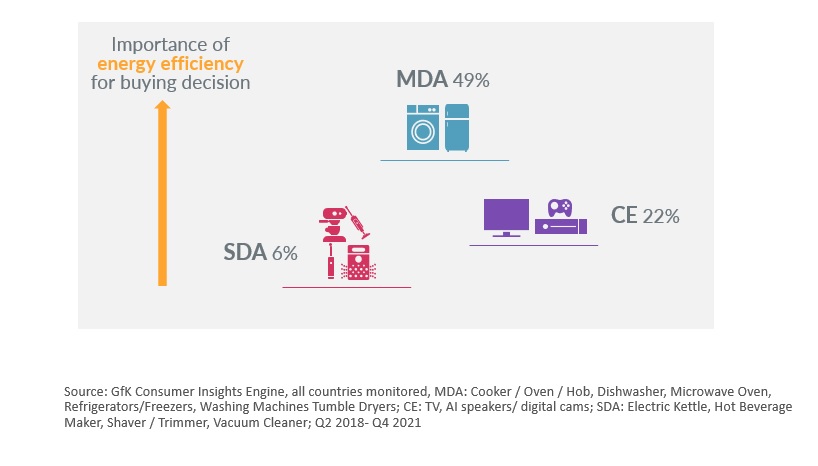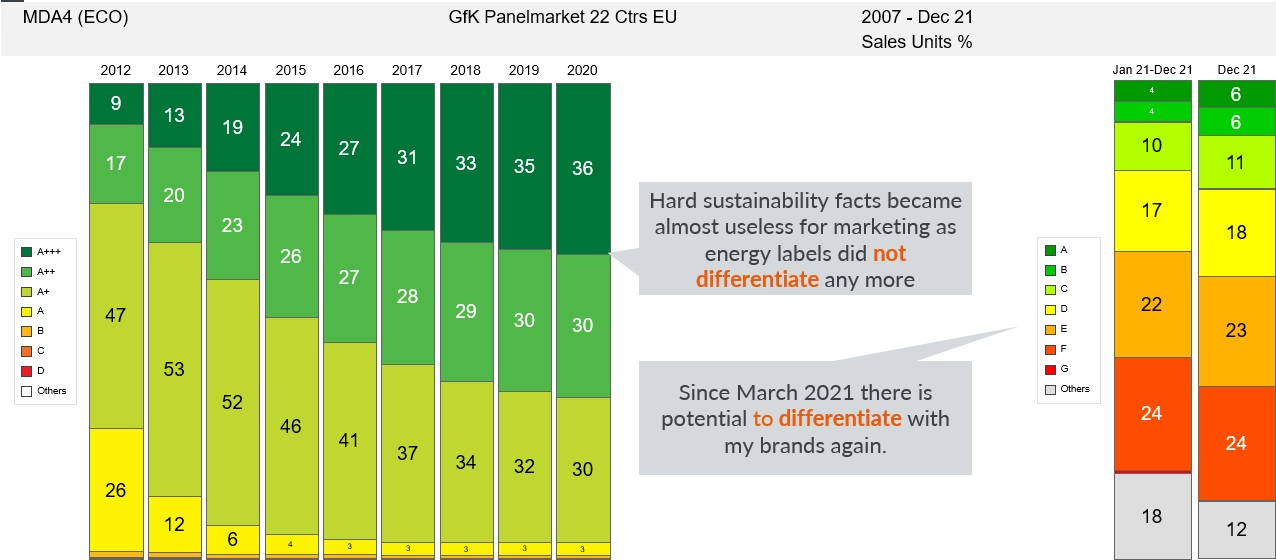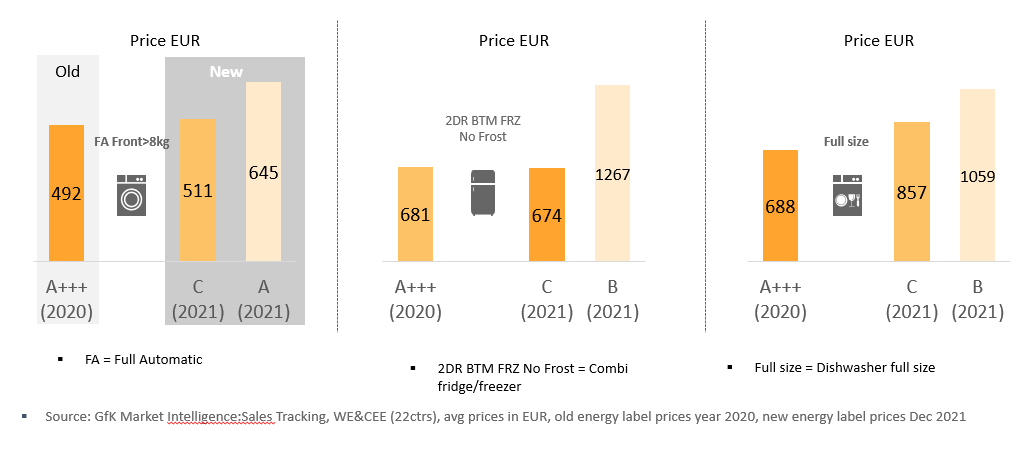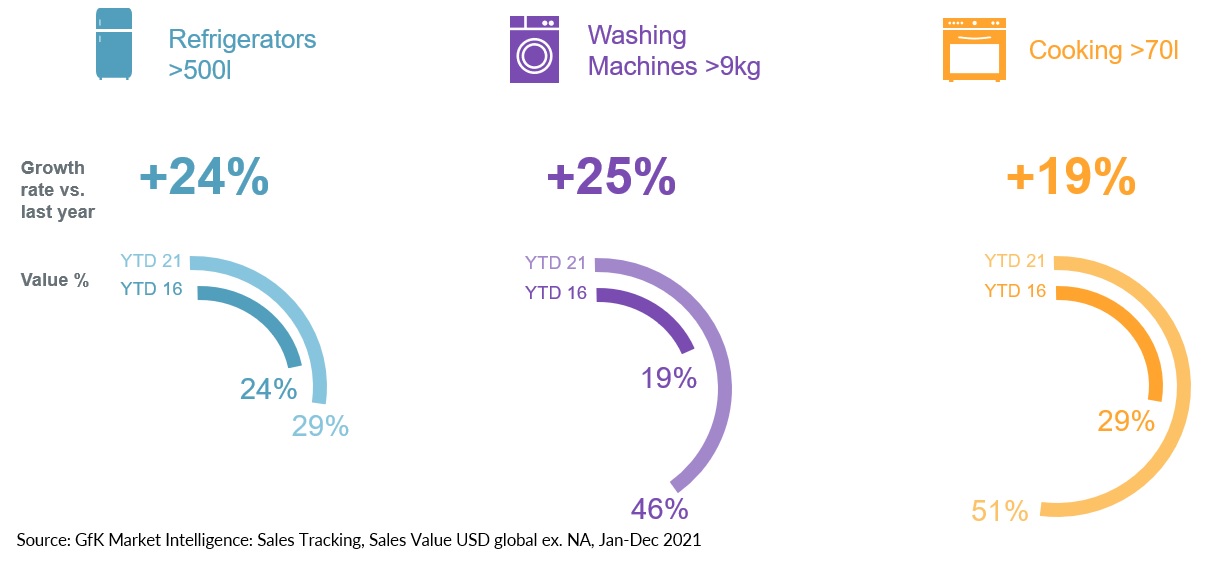It may be counterintuitive to expect consumers to pay premium prices for high-performance or sustainable products during a cost-of-living crisis. But as householders tighten belts, they are resisting impulse buys and looking for products that will save them money in the long run.
High electricity bills are a fact of life for the foreseeable future and climate change is a growing concern for consumers, so best-in-class energy efficiency features are becoming more attractive, even if they come with a higher price tag.
The problem for shoppers is that high performance often equates to high capacity and high-end additional features that add up to high absolute energy consumption, wiping out long-term cost savings. Here we look at the business opportunity this presents forward-thinking brands and how they can hit the energy efficiency sweet spot to justify premium prices.
Energy efficiency receives a boost
Even before global energy prices began skyrocketing due to post-pandemic demand and Western tensions with Russia over the war in Ukraine, energy efficiency was already gaining traction in consumer buying decisions.
Almost half of consumers (49%) consider it an important criterion when buying major domestic appliances (MDA), and increasingly we may see this for other categories too.
When it comes to consumer electronics (CE), other performance features such as size, capacity, audio and picture quality have historically played a more prominent role, and energy efficiency is rarely mentioned as a criterion for IT and smartphone purchases except in terms of battery life. However, sustainability features are set to become more differentiating in the future, with 22% of consumers already saying that energy efficiency is an important consideration when buying consumer electronics devices. The same goes for small domestic appliances (SDA) for which only 6% of consumers currently consider energy efficiency a significant influence on their product choices.

MDAs lead the way
In Europe, new energy labels for large home appliances have rejuvenated marketing for performance and sustainability. Back in 2020, best-in-class energy efficiency had become almost useless as a product differentiator because 96% of appliances sold were rated A or above. In fact, 36% displayed the highest possible A+++ label, compared with only 9% in 2012.

Since the revised A-G labels were introduced in March 2021, however, high-performing appliances have gained more prominence, with just 6% of units sold in December 2021 awarded the highest possible A rating, and over two-thirds rated D or below.
Sustainable brands have seized the opportunity to upsell based on the promise of significantly higher energy efficiency. Whereas an average A+++ dishwasher was priced at €688 in 2020, a year later retailers could charge €857 for a C-rated model – almost 25% more. The contrast was even starker for two-door bottom freezer refrigerators. In 2020, a typical A+++ appliance went for €681. By 2021, a typical B-rated model fetched almost twice the price at €1,267.
W.Europe & E.Europe: Old vs new energy label avg prices EUR

Do these pricier high-performance models pay off for consumers in the long run? Not necessarily, or at least, not yet. When GfK analysed the total cost of ownership of a typical washing machine assuming a 12-year lifecycle and factoring in both the price and lifetime water and energy usage, we found that premiumization of the most energy efficient products was not fully justified in 2019, 2020 or 2021, because the financial benefits faded away in a rational cost evaluation.[1]
However, by February 2022, average prices for both A-rated and B-rated had come down to more competitive levels while the cost of D-rated appliances remained static, thereby narrowing the total cost of ownership gap.
Since then, Russia’s invasion of Ukraine has disrupted global energy markets and sent household electricity bills soaring, particularly in Europe. With domestic fuel bills now at high levels, we expect A and B-rated home appliances to present a real cost benefit over their lifecycles when 2022 energy costs are factored into the calculations.
The energy efficiency sweet spot
Sustainability is a long-term imperative for success, with many brands working hard to reduce the impact of their products. Despite the challenging macro environment, it is important that brands maintain their focus on sustainability as demand for it is expected to grow in coming years. Not only is legislative pressure mounting on companies, but consumers are increasingly demanding eco-conscious products.
At face value though, the growing demand for sustainability is at odds with consumer appetite for high performance as epitomized by large and energy-hungry domestic appliances. Indeed, in recent years, consumers have prized high capacity over long-term energy savings when upgrading their ovens, washing machines and refrigerators. Cooking appliances with 70l capacity or more grew in value by 19% in 2021 and now dominate the market in terms of value share (51%). Washing machines that can take loads over 9kg grew by 25% and refrigerators over 500l by 24%, continuing this long-term trend.

Appliances have become more efficient, but the growth of high-capacity models in the assortment mix has wiped out total energy savings in the MDA category. Between 2016 and 2021, the average energy consumption of refrigerators sold in Europe fell by just 1% due to the mix of different product types. This is despite the fact that average energy consumption for some individual segments, like side-by-side fridge-freezers, fell by more than 10%.
Consumers who do want to buy smaller appliances to keep their bills down face a problem – a shortage of high-performing, energy-efficient machines. A GfK analysis of top selling washing machines with capacity of less than 7kg on the German market in the year up to February 2022 found that none had energy efficiency labels above a D-rating, fewer than half had inverters, none were smart, and none had steam functions. The average selling price was €248. Only if consumers wanted a load capacity of 8kg or more were they offered smart machines with steam functions, inverters and best-in-class energy efficiency. These larger appliances commanded an average price of €638.
For forward-thinking brands, there is a potential business opportunity. Smaller appliances with strong performance features and low absolute energy consumption could command higher prices.
Conclusion
At a time of high anxiety over energy bills and the cost of living, sustainable brands should clearly link high performance to sustainability and efficiency in their messaging. Those that can demonstrate long-term cost savings over the lifecycle of their energy efficient products will have the advantage.
MDA brands, in particular, have an opportunity to fulfil an unmet consumer need for smaller, smart and efficient appliances that are cost-effective in the long run. By positioning these products as an ‘investment in efficiency’ they can attract consumers prepared to pay a premium, even in these challenging times.
Learn how to seize these opportunities below.

[1] GfK Market Intelligence, DE, Washingmachines; *12 yrs lifecycle, 220 cycles p.a.





